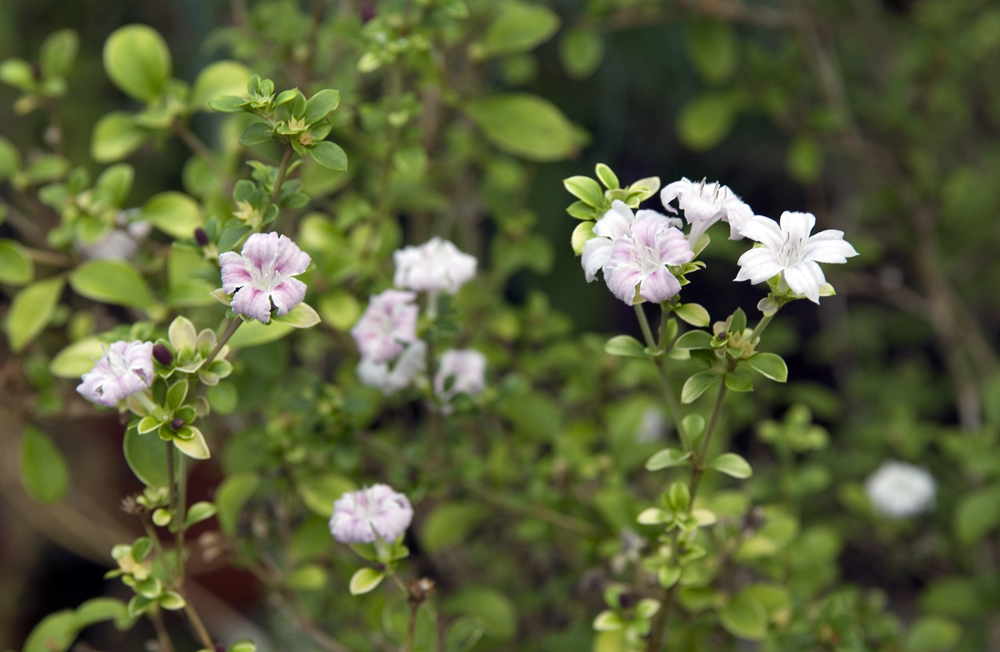Serissa foetida
Common Name:
Serissa, Tree of a Thousand Stars

General information:
These small shrubs are much loved as bonsai for their tiny flowers which may occur 2-3 times yearly, gnarled trunks, and naturally miniature leaves. Most bonsai are S. foetida, of which many cultivars are available.
Probably the two most common bonsai purchased by the casual bonsai buyer in America are Juniperus and Serissa. Judging from the number of junked junipers and shriveled Serissas, beginners would be far happier with elm and Ficus. Serissa is a notoriously fussy bonsai. The good news is that they aren’t that hard to keep alive. But considering that most people buy Serissa on impulse because the plant is so spectacular at the store, the bad news is bad indeed. The plant will generally drop its flowers within a day or two. Then the plant will drop its leaves. If the grower doesn’t panic (and many Serissas are inadvertently killed by panicking beginners who respond by drastically over/under-watering the plant) the plant will soon regrow its leaves. A power struggle then ensues. The grower soon discovers that the Serissa drops its leaves if it has too much water. Too little water. If it’s too hot or too cold. If it’s moved, or there is a shift in lighting or temperature.
Lighting:
Partial sun for S. foetida, full sun for S. crassiramea. If kept indoors, needs 1000 Lux. Use of grow lamps for 12 hours daily is beneficial. Too little light will result in leggy growth.
Temperature:
Hardy to zone 9. Some growers bring them in when temps drop to 50F, others leave them outside until temps are in the 20s! Ideal winter temperatures range from 50-68F. More important than the actual temperature seems to be two factors: the plant dislikes a sudden change in lighting (many die from lack of light when brought indoors) and individual plants may be show different hardinesses (a Serissa grown outdoors from youth will withstand a greater variation in temperature than a Serissa purchased from a greenhouse). If brought indoors, do not position this plant near a heat source, or it will lose leaves. If kept outdoors year round, will drop leaves as the temperatures become colder.
Watering:
Keep evenly moist. It generally needs lots of water during warm weather, so much that some authorities recommend placing the Serissa in a tray of water. Others warn against this, as it encourages root rot. Serissa is not a natural water-lover like bald cypress, so a water tray should not be necessary if you faithfully water at the first sign of dryness. However, if Serissa dries out, it will soon drop its leaves. If this occurs, remember to reduce watering until the leaves return, or root rot may ensue. Some recommend misting in dry weather. Some recommend daily misting, but do not mist while in bloom as this causes the flowers to rot. Placing the Serissa on a moisture tray is another option.
Feeding:
Every 10-14 days during growth, every 4-6 weeks in winter, using liquid bonsai food or half-strength plant food. Likes slightly acid soil conditions, so the occasional application of Miracid is appreciated.
Pruning and wiring:
When in bloom, remove fading flowers to encourage further flower production. Prune as needed; the Serissa is a fast grower and may need radical or repeated pruning to maintain its shape. Will bud back on old wood; in fact, some books recommend occasionally pruning back beyond old growth to help the plant maintain its shape. Wire during the growing period. Serissa will grow air roots and is often used in exposed root or root over rock styles. Eliminate unwanted suckers extending from the base. Suitable for all styles except formal upright and broom. Suitable for extra small to medium sizes.
Propagation:
Cuttings root quite easily. Lesniewicz recommends using 4 inch cuttings in a glass of water from early summer on. The Samsons recommend bottom heat which would probably induce rooting faster.
Repotting:
Every 1-2 years in spring. The newly pruned roots will emit a wretched odour! Prune roots moderately, and use basic bonsai soil.
Pests and diseases:
Red spider mite, scale, woolly aphids, mildew. Pests are usually not as much of a problem as a sudden change in conditions such as light, temperature, etc.
Some species suitable for bonsai:
Serissa crassiramea: Makino serissa - A broad leaved shrub. It bears white flowers.
Serissa foetida (also called S. japonica): tree of a thousand stars, snow rose, June snow - Many cultivars are available, including single and double flowered varieties. Emits an unpleasant smell when pruned, hence the name.
Serissa foetida ‘Chinese’ - small tubular white flowers which bloom only sporadically. Light green foliage.
Serissa foetida ‘Flore Pleno’ - double white flowers which are produced throughout the year. Dark green foliage.
Serissa foetida ‘Kyoto’ - a very tiny dwarf with single white flowers - rarely grows over a foot high.
Serissa foetida ‘Kyoto Variegated’ - Just what it says.
Serissa foetida ‘Mt. Fuji’ - This cultivar has larger leaves and a thicker stem than other Serissas. It is strongly variegated, with single white flowers. Variegation changes throughout the year, based on temperature, light and nutrient content.
Serissa foetida ‘Pink Mountain’ - A slow growing cv. with variegated foliage in winter and single pink flowers.
Serissa foetida ‘Pink Princess’ - Light pink buds opening to white, tubular flowers.
Serissa foetida rosea ‘Ahiro Pink’ - single pink flowers, variegated foliage.
Serissa foetida rosea ‘Cherry Blossom’ - single pink blossoms, variegated foliage.
Serissa foetida rosea ‘Pink Swan’ - single pink flowers, variegated foliage.
Serissa foetida rosea ‘Tancho’ - single pink flowers, variegated foliage.
Serissa foetida ‘Variegata’ -green leaves, with yellow or cream colored margins.
Serissa foetida ‘White Swan’ - single white flowers, variegated foliage. Reputedly stronger than the average Serissa, this cv. forms trunks quickly and seems resistant to the normal Serissa fussiness!
Serissa foetida ‘Yatsubusa’ - Very dwarf cv. with tiny pink and tiny dark green congested foliage.
Compiled by Sabrina Caine
